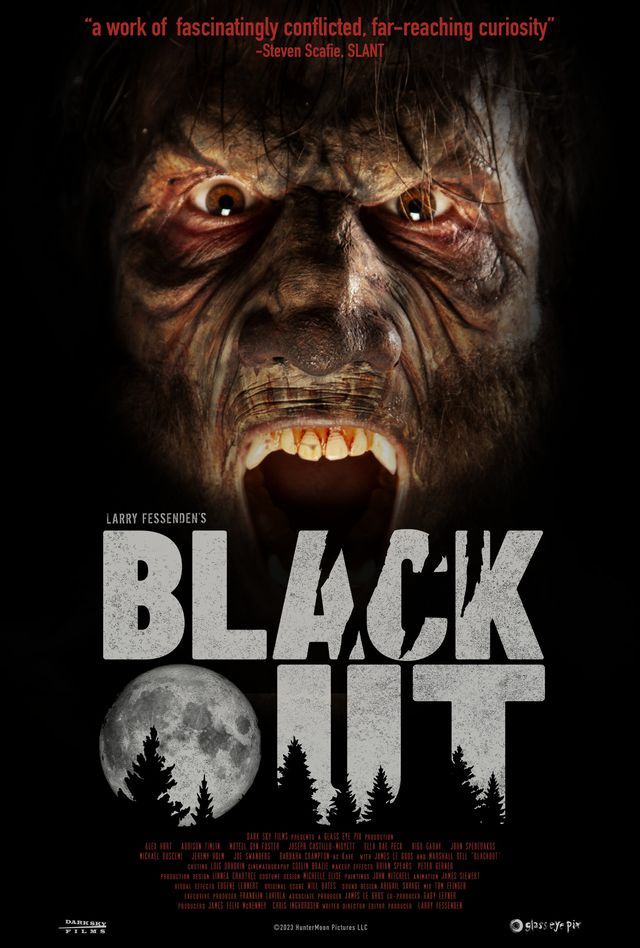Summary
- Worthy subject matter, themes & strong performances are marred by an overstuffed, tedious plot.
- Interesting experimental flourishes can’t overcome the jarring shifts between political drama & werewolf horror.
- An ambitious narrative tackles addiction, corruption, atonement, and prejudice with varying success.
Larry Fessenden’s Blackout is a frustrating bouillabaisse of two completely different movies that happen to be playing at the same time. One is a tale of small-town political corruption, racial injustice, and environmental activism that puts the “slow” in slow burn. The other is a Hammer horror redux starring a werewolf with a penchant for neck-slicing. Sadly, neither works.
When the sun goes down Charley has convulsions while driving his car, goes off the road and ends up in a ditch. Charley, it seems, is a werewolf. He attacks his rescuers and moves through the outskirts of town at night wreaking havoc. But the next day he can’t remember the things he’s done.
- Worthy subject matter and timely themes
- Some strong performances
- Interesting experimental flourishes, such as animated scenes
- Tedious and at times incomprehensible plot
- Jarring shifts between political drama and werewolf horror
- Over-stuffed story impacting character development
Blackout’s Ambition Can’t Make Up For A Plodding Narrative
The film’s interesting ideas never manage to deliver
The meandering story, which veers between explosions of surprisingly bloody violence and bloated conversations that make Killers of the Flower Moon feel as frenetic as Mad Max, revolves around Charley (Alex Hurt), an inexplicably popular artist and erstwhile decorator. An alcoholic haunted by his past, Charley spends most of the first act driving around a nondescript American town, desperately trying to put his affairs in order before leaving for good.
As he runs various errands, we learn about an evil hotelier, who’s bad for unknown reasons; Charley’s former flame and the hotelier’s daughter, who runs the world’s saddest florist; and a “big city lawyer” who seems extremely keen on the tortured artisan, despite his total refusal to paint her shed. Undeterred by Charley’s failure to meet his contractual obligations, the lawyer agrees to use Charley’s intel to help bring down the nasty resort manager.

Related
10 Best Werewolf Movies Of All Time
While werewolves haven’t received as much cinematic love as vampires, zombies, or ghosts, there are plenty of classics to watch when the moon is full.
So far, so boring. Suddenly, as Charley takes to the road one last time, night falls, and the werewolf action begins. Then it stops again, and we’re back trying to unravel the Gordian knot of Nowhereville’s political landscape.
Subplots head for the trees as soon as the werewolf appears, and characters are given insufficient time to develop.
Blackout‘s intention is clear. After suffering his bouts of lycanthropy, Charley is incapable of remembering anything, except for gruesome flashes of death and dismemberment. His transformation serves as a metaphor for his alcoholism, allowing the film to explore themes of guilt and trauma through the prism of a hairy wolfman. However, for all its ambition, the film comes off as overstuffed and underbaked. Subplots head for the trees as soon as the werewolf appears, and characters are given insufficient time to develop. Almost every victim is completely anonymous, making it hard to care about who’s getting their face chewed off.
This lack of focus is most obvious in one of Blackout‘s more interesting narrative tangents. After witnessing one of the werewolf murders, Mexican laborer Miguel (Rigo Garay) becomes public enemy number one, falsely accused by dim-witted locals and powerful political figures alike. The movie attempts to use Miguel’s experience to examine interracial tension and the miscarriage of justice. Yet despite this story’s potential, the bigoted caricatures that make up the community and Miguel’s limited screen time leave it feeling like an afterthought. Like many ideas in Blackout, it is presented and then never fully explored.
Blackout (2024)
- Director
-
Larry Fessenden
- Release Date
-
April 12, 2024
- Studio(s)
-
Glass Eye Pix
- Distributor(s)
-
Dark Sky Films
- Writers
-
Larry Fessenden
- Cast
-
Marshall Bell
, Michael Buscemi
, Joseph Castillo-Midyett
, Kevin Corrigan
, Barbara Crampton
, Stirling duBell - Runtime
-
104 Minutes
Blackout’s Competing Ideas Limit Its Effectiveness
There’s enough to suggest the premise has merit
Part of the frustration with the film is that there are interesting isolated elements within it. As well as its noble messaging, Blackout also includes some eerily surreal animated scenes, with lycanthrope transformation realized on a Van Gogh-like canvas. These moments are surprisingly haunting compared to the rest of the movie’s tedious melodrama and constitute some of Blackout‘s most potent scenes. Had the film been bolder and committed to one style, message, or story, it’s easy to see how it could have been a success.
…the movie’s performances fluctuate from the affecting to the frustrating.
Likewise, the movie’s performances fluctuate from the affecting to the frustrating. Alex Hurt is suitably brooding as Charley, while Addison Timlin and Motell Gyn Foster provide emotionally charged support. However, on the flip side, other characters come across as unintentionally pantomime – often when sincerity is required to help the scene succeed. This blend only adds to the sense that Blackout is trying to combine too many different styles and stories into one 100-minute creature feature.
As it is, Blackout is a confused missed opportunity. Neither an enjoyably schlocky horror nor an emotionally effective thriller, the movie’s genre mash-up never quite manages to come together. There’s enough here to suggest that the wolfman device really is an interesting way to explore themes of addiction, corruption, atonement, and prejudice. Unfortunately, trying to address them all at once leads to an outcome that’s as messy as a werewolf’s haircut.




